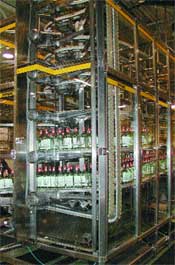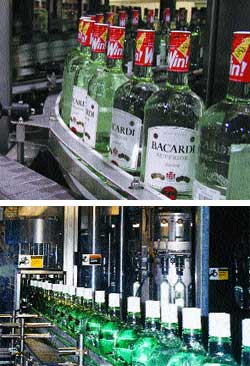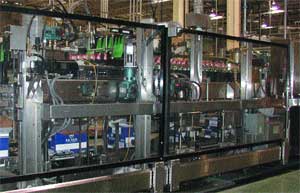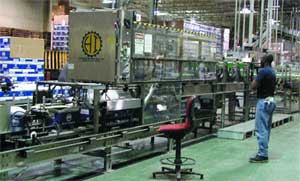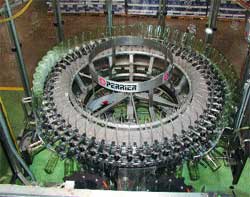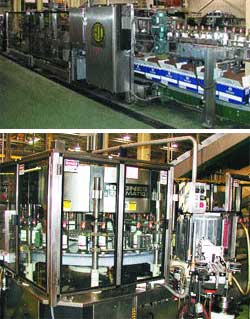January 29, 2014

While PD has been covering the Bacardi Company's unique rum-bottling lines and a state-of-the-art facility in sunny, Jacksonville, FL, (see PD, October, '02, p. 38 and August, '02, p. 54), our neighbors to the North, at Bacardi Canada, are not to be outdone. Bacardi's operation in Brampton, ON, one of 11 Bacardi plants worldwide, has made plenty of its own technological strides. Recently, Bacardi Canada toasted the end of its search for a revolutionary bottle conveyor/accumulator for a high-speed spirits line, with the installation of the Dynac™ 6400 H dynamic accumulator/conveyor from Hartness International.
A most unusual conveying system in various respects (see PD, January, '00, p. 38), the compact conveyor/ accumulator smoothly and automatically responds to production line flow changes and package configuration switches in real time, providing true, pressureless, first-in/first-out sequencing of a variety of round and nonround bottles in both glass and plastic.
Proving to be a high performer for Bacardi Canada, the system has the flexibility and capacity for the firm's substantial output of Bacardi Premium white rum and Russian Prince vodkas in assorted bottle types–as much as 11,000 cases of liquor per shift.
"That's nothing for us to produce," points out Dave Schroeder, vp of production. "We run about nine different bottle skus on the line for rum and other liquors, so we're very pleased with the Dynac system. We've cut bottle damage by as much as ninety percent. Now, we're even more excited because we just recently started running a 375-mL size on the line and it really works well."
So well, that Schroeder says a Bacardi plant in Puerto Rico is very interested in installing a Dynac system.
Buying time and space
Line 4, which is, oddly enough, one of three lines in the Brampton plant, fills the nine major stockkeeping units in Bacardi Canada's spirits lineup, which is sold in Canada only. The line includes both glass and polyethylene terephthalate bottles in oval, round and flask shapes in 750-mL and 1-, 1.14- and 1.75-L sizes, as well as a new 375-mL size in PET. Therefore, flexibility is indeed important.
Many bottling plants add product-accumulating niches that provide needed space to buy time. This is usually done with lengthy, large, space-eating systems. Bacardi Canada wanted something quite the opposite for the Brampton plant.
The new conveying/accumulation equipment had to be capable of running both the lightweight, easily toppled PET bottles and the heavier glass bottles in their different configurations while being quick to change over, Schroeder says.
Officially unveiled at a Pack Expo '00, with a prototype showcased for private viewing at the '98 show, the Dynac system is now available in a series of models available for single-file and mass-flow applications, aimed at transporting cartons, bottles, flexible packages and other container structures. Serving as an alternative to the use of multiple serpentine conveyors to accumulate nonround bottles, the conveyor design impressed Schroeder and his team with its ability to modulate product flow with no pressure, down to a single container.
Customized for Bacardi's nonround, flask-shaped and somewhat reverse-tapered bottles–which are atypical of what Dynacs have run in the past–the 6400 H system, with its 4.5-in.-wide conveyor chain, provides a comfortable three minutes of accumulation time, with solid, first-in/first-out sequencing and smooth, even spacing of outbound bottles. This facilitates bottling functions downstream.
This was something of a problem in the past. Prior to the installation of the Dynac system, the line was modified to run the increasingly popular narrow-neck press-and-blow-style glass bottle, which is lighter in weight than traditional glass, Schroeder tells PD. Modifying the line to handle these lighter-weight bottles was done with the goal of minimizing line pressure and eliminating damage.
But line flow continued to show signs of problems, especially with the press-and-blow glass bottles, Schroeder says.
"The different bottle formats are sometimes difficult to handle," echoes Hartness' Doug Stambaugh, southeast regional manager and national accounts manager for Bacardi. "The narrow-neck press-and-blow glass didn't like accumulating on conveyors and had a very short amount of space between labeling and case packing for accumulation. Our biggest challenge in developing this Dynac for Bacardi Canada was to run their very tallest bottles at such high speeds and maintain package stability as the bottles made some pretty tight turns. We came up with a differently pitched machine and a rubberized-surface conveyor top, which ended that issue."
It would take time to ramp up again if bottles contacted or jammed, Schroeder adds. "Not any more." Not only is it vertical, the Dynac, as the name implies, is dynamic, responding to product flow changes in real time (Model 6400 H is a taller system than the other machines in the Dynac line and handles bottles measuring up to 17 in. tall).
Measuring a tidy 7.16 x 17.8 x 12.75 ft, the vertical, rectangularly constructed system reduces space requirements, eliminating complex line controls and bottle pressure. This ultimately has increased overall efficiencies on Bacardi's Line 4 by as much as 5 percent, Schroeder says. This benefit also factors in lower line downtime due to fewer jams coupled with less bottle breakage.
|
Rum bottles gently travel through the twin-tier spiral accumulator as the bottling line outputs as many as 300 bpm. The unit has 300 ft of available conveyor surface that provides four minutes of accumulation time. |
"Most plants don't have much linear floorspace," adds Stambaugh. "An objective with designing Dynac systems was to take advantage of the vertical space most plants have. The conveyor is similar to a rubber band: It stays short in length, but if it needs to expand, it can." Humming along at a continuous 81-percent efficiency rate, Line 4 runs as many 300 bottles/min, and is in operation five days a week. Constantly being evaluated and upgraded, the line was built between '93 and '94 for spirits, and features equipment from Krones and Perrier as well as from Hartness. All of the equipment was chosen to best suit the line's output, Schroeder says.
|
Filled, capped, labeled bottles, top , round a bend to the infeed of the accumulator. Capped bottles, bottom, exit the rinser/filler/capper station. The 63-valve filler appears in the background. |
Explains Bacardi Canada's maintenance supervisor, Alan Dyck, at first, there was a bit of trepidation in watching 1-L bottles of premium rum briskly enter and exit just as quickly, traveling at rates upwards of 300 bottles/min, with only 1/2-in. of space between each bottle. "We were a little intimidated by it at first, because there are no conventional guiderails to keep the product on the conveyor [there are ridges on the outside of the chain], Dyck says. "But once we integrated the system into the line, our worries were put to rest."
A series of sensors vary the speed of the high-friction belt conveyor infeed codeveloped with Hartness by Intralox with a snap-on top. When the sensors detect incoming production flow, the conveyor creates gaps between the bottles.
Flexibility plus
Acting as a flexible buffer that accumulates five layers of as many as 1,000 bottles at a time, despite changes in package flow, the new spiral accumulation/conveying system helps to isolate the filler from downstream operations, Hartness tells PD. Hartness installed the 6400 H in December, '01, between a Krones Topmatic 28-bottleplate cold-glue labeler, a Hartness laner and a Hartness 2900 drop packer. Governed by an Allen-Bradley SLC/504 control system, the Dynac uses its conveyors independently, to adjust its speeds and bottle flow in order to accommodate upstream and downstream equipment without operator intervention. This can reduce labor and efficiently meter downstream equipment. That's critical at Bacardi, Schroeder says. Filler and labeler uptime must be maintained, he explains. "If that drops off for whatever reason, product can be lost."
Modified to work with bottles much larger than those for which the original Dynacs were designed (see PD, January, '00, p. 38), the 6400 H is gentle with a very expensive product, Schroeder tells PD. "We're talking about a premium rum, so each bottle can cost between thirty and forty dollars, depending on the product, and we can have 1,000-plus bottles running on this machine at a time. We save a lot of money in bottle breakage and product. That's especially important here in Canada, because we also have to include the heavy taxation fees. We really don't want to be dropping and smashing bottles, so we have nothing but accolades for the Dynac system."
Rinsing, filling, capping
Empty bottles arrive from various suppliers packed in reshippers. Saint-Gobain and Owens-Illinois provide the glass bottles. Amcor supplies the PET bottles. After the bottles are decased, two cases at a time from corrugated reshippers on a Hartness D-1000 unit, they single-file to the monoblocked rinser/filler and capper, furnished by Perrier, Krones and Zalkin, respectively. The stainless-steel, 56-head rotary rinser is linked with a Krones VVGV (vacuum/valve/gravity/vacuum) rotary 63-valve filler and a nine-head Zalkin rotary capper (provided in the U.S. by Fowler Products) driven off of the filler. Opaque white, tamper-evident plastic caps for the PET bottles are from Kerr. Long-skirted Stele extruded aluminum closures for the glass bottles are from Pechiney. All present the Bacardi bat logo and other brand information, printed in gold and black.
|
Incoming rum bottles are decased and actually rinsed with rum before filling. Prior to casing, bottles are divided into lanes and are smoothly metered into a servo drop packer that vertically loads them into cases. |
Bottles enter the rotary rinser (represented in the U.S. by Serac and Pechiney Cork & Seal of California and in Canada by Newmapak Ltd.) neck-up and are inverted 180 deg to be rinsed with spirits. The bottles are then mechanically lowered onto their bases and convey through the rotary filling system and then to the capper.
All of the bottles feature the company's famous batwing logo also displayed prominently on its labels. The filled, capped bottles are then labeled on the Topmatic system with a set of the famous but difficult-to-apply Bacardi labels that include the company's noted batwing cartouche, or logo, overlapping the top and bottom labels on the main panel. "We have exceptionally fine operators here who have mastered the label application pretty quickly," Schroeder tells PD.
The bottles then convey in single-file to the Dynac two-tier spiral accumulator.
|
Corrugated reshippers are unloaded at the start of a bottling run, travel overhead through the packaging operation, around to the other side of Line 4 and line up to be reloaded with filled, sealed spirits bottles. |
With a modular extension at the infeed, the unit has 300 ft of available conveyor surface that provide at least four minutes of accumulation time.
At the start of a production run, the machine will sit idle until a sufficient queue of bottles is present at its infeed. The machine then will run its conveyors and move bottles through the system, assuming there's enough to maintain the appropriate population within the machine. The Dynac has two speeds that allow it to be tuned in to the specific needs of the line and of the product's characteristics.
'Spider' transfer
Parallel, independently driven infeed and outfeed conveyors about 10 in. apart from each other operate in opposite directions and are mechanically linked by a free-floating gear.
|
A 56-head rotary rinser from France inverts the bottles and sprays them with spirits before they're filled and capped. |
The gear, or package-transfer mechanism, is nicknamed "the spider." The spider moves up and continually increases or decreases the length of the conveyor using a horseshoe-shaped guide, as if the system were breathing, giving the conveyor an expandable surface area that moves bottles up a vertical plane as they accumulate, allowing Bacardi to store more and more bottles. Each bottle basically lays claim to its own space, so conventional guiderails aren't necessary. Sensors monitor bottle flow and adjust the conveyor speeds accordingly.
"The spider gives us the ability to index bottles and maintain momentum," Schroeder explains. "We essentially have one spider for round and one for nonround bottles due to the variety of container shapes and sizes. The device has to keep the bottles in control as it moves up and down the different elevations of accumulator. The Dynac is like a big surge tank between two major machines. The liquor-bottling industry desperately needed this technology. Nobody came up with it until Hartness did."
When a group of bottles encounters the spider's transfer device, it is moved to the discharge conveyor. If either conveyor slows or stops due to production problems, the spider gear moves in the direction of the moving conveyor. Bottles are automatically collected along both conveyors in a sequential first-in/first-out loop until the problem is solved. A horseshoe-shaped guide linked to the center wheel of the spider mechanism controls bottle flow on the belt, providing a unique ability to increase or decrease the conveyor length automatically by pulling bottles in or letting them travel farther downstream, if necessary.
Optimally, when the infeed and outfeed conveyor speeds match, the spider will stay in the bottom tier of the system, so it is able to accumulate a large number of bottles at any given moment. The spider remains in place at the bottom of a spiral, or helix, rotating and transferring product from one conveyor to the other. When the outfeed belt is running slower than the infeed belt, the mechanically driven spider travels up the spiral and fills up more of the outfeed.
|
Bottles receive the company's famous batwing logo label, applied by a 28-bottleplate labeler, bottom, before the bottles reach the spiral accumulating conveyor. Top, bottles are loaded into cases that are hot-melt-sealed. |
Conversely, when the infeed conveyor is running slower, the faster-moving outfeed conveyor begins to empty, so the spider travels down the spiral as it transfers bottles. The rum bottles are discharged and progress about 4 to 5 ft to the case packer, all the while, distributed with zero pressure. The discharge speed will decrease if bottles back up for any reason.
Prior to case packing, however, bottles are split into as many as four lanes by a Hartness laner that meters the bottles to the infeed of the closed-loop, servo-controlled, 2900 vertical-load drop packer. Also designed for nonround, oval and other bottles that can be somewhat difficult to handle, the drop packer uses air-inflated panels to gently draw groups of the sealed bottles onto a grid zone where the inflated panels now deflate and gently release and lower the groups of bottles into blue-and-white-printed reshipper cases in counts of six to 24. The 32 ECT single-wall cases supplied by several sources, including Smurfit-Stone Display Group, are top-sealed with hot-melt adhesive on a Hartness CTS-30 case sealer.
Quick changeovers on the line were a must, Schroeder points out, since Line 4 runs so many different bottle configurations. The Dynac poses no problem here. The spider transfer portion of the Dynac system can be swapped for a different part, and with a few tool-less adjustments on the infeed, outfeed and horseshoe guide for different bottle sizes, along with keying in a new selection into the system's control panel, a changeover takes about five minutes or less.
Peak efficiency
In fact, the line is so efficient, Schroeder indicates that Bacardi Canada is putting it into service about 85 percent of the time on all of the major skus produced at the plant. "This system is such a huge benefit for us, we've had other companies visit to see this technology. We feel we have the best in the business on that line in terms of packaging machinery. "
More information is available:
Conveyor/accumulator, decaser, case packer, laner, case sealer: Hartness Intl., 864/287-1200. Circle No. 224.
Infeed belt codevelopment: Intralox, Inc., 800/535-8848. Circle No. 225.
Filler, labeler: Krones, Inc., 414/409-4000. Circle No. 226.
Bottle rinser distributor: Pechiney Cork & Seal of California, 707/257-6481. Circle No. 227.
Bottle rinser distributor: Serac, Inc., 630/510-9343. Circle No. 228.
Bottle rinser: Newmapak, Ltd.,514/866-5572. Circle No. 229.
Capper: Fowler Products Co., 706/549-3000. Circle No. 230.
Glass bottles: Saint-Gobain Containers, 765/741-7000. Circle No. 231.
Glass bottles: Owens-Illinois, 419-247-5000. Circle No. 232.
PET bottles: Amcor PET Packaging, 734/428-9741. Circle No. 233.
Caps: Kerr Group, Inc., 800/367-1876. Circle No. 234.
Caps: Pechiney/Capulux, 450/469-0777. Circle No. 235.
Controls: Allen-Bradley Co., 414/382-2000. Circle No. 236.
Cases: Smurfit-Stone Display Group, 877/772-2932. Circle No. 237.
About the Author(s)
You May Also Like
